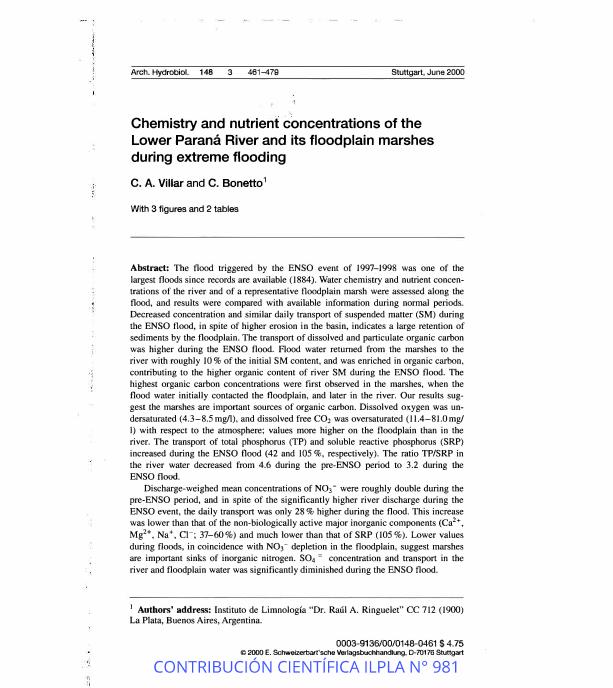Artículo
Chemistry and nutrient concentrations of the Lower Paraná River and its floodplain marshes during extreme flooding.
Fecha de publicación:
12/2000
Editorial:
E Schweizerbartsche Verlags
Revista:
Fundamental and Applied Limnology
ISSN:
0003-9136
Idioma:
Inglés
Tipo de recurso:
Artículo publicado
Clasificación temática:
Resumen
The flood triggered by the ENSO event of 1997-1998 was one of the largest floods since records are available (1884). Water chemistry and nutrient concentrations of the river and of a representative floodplain marsh were assessed along the flood, and results were compared with available information during normal periods. Decreased concentration and similar daily transport of suspended matter (SM) during the ENSO flood, in spite of higher erosion in the basin, indicates a large retention of sediments by the floodplain. The transport of dissolved and particulate organic carbon was higher during the ENSO flood. Flood water returned from the marshes to the river with roughly 10 % of the initial SM content, and was enriched in organic carbon, contributing to the higher organic content of river SM during the ENSO flood. The highest organic carbon concentrations were first observed in the marshes, when the flood water initially contacted the floodplain, and later in the river. Our results suggest the marshes are important sources of organic carbon. Dissolved oxygen was undersaturated (4.3-8.5 mg/l), and dissolved free CO2 was oversaturated (11.4-81.0 mg/l) with respect to the atmosphere; values more higher on the floodplain than in the river. The transport of total phosphorus (TP) and soluble reactive phosphorus (SRP) increased during the ENSO flood (42 and 105 %, respectively). The ratio TP/SRP in the river water decreased from 4.6 during the pre-ENSO period to 3.2 during the ENSO flood. Discharge-weighed mean concentrations of NO3- were roughly double during the pre-ENSO period, and in spite of the significantly higher river discharge during the ENSO event, the daily transport was only 28% higher during the flood. This increase was lower than that of the non-biologically active major inorganic components (Ca2+ Mg2+ Na+ Cl- · 37- 60 %) and much lower than that of SRP (105 %). Lower values during floods, in coincidence with NO3- depletion in the floodplain, suggest marshes are important sinks of inorganic nitrogen. SO4 concentration and transport in the river and floodplain water was significantly diminished during the ENSO flood.
Archivos asociados
Licencia
Identificadores
Colecciones
Articulos(CCT - LA PLATA)
Articulos de CTRO.CIENTIFICO TECNOL.CONICET - LA PLATA
Articulos de CTRO.CIENTIFICO TECNOL.CONICET - LA PLATA
Citación
Villar, Alejandra Clara; Bonetto, Carlos Alberto; Chemistry and nutrient concentrations of the Lower Paraná River and its floodplain marshes during extreme flooding.; E Schweizerbartsche Verlags; Fundamental and Applied Limnology; 148; 3; 12-2000; 461-479
Compartir
Altmétricas




